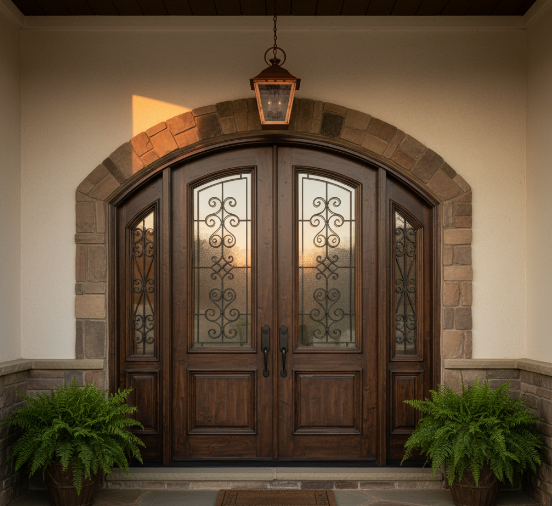We may only think of doors as panels that open and close. But they are so much more than that! Doors are a combination of carefully designed components that work together to provide security, insulation, durability, energy efficiency, and style. When you’re shopping for new exterior doors or considering a renovation, understanding the different parts of a door helps you make smarter, more confident choices. From the door frame to the smallest pieces of hardware, every detail plays an important role in how your door looks, functions, and performs in the Canadian climate year after year.
This guide discusses all door parts, explains what each one does, and provides clear terminology you can confidently use when talking with contractors, visiting a showroom, or comparing options for your home.
All The Parts Of A Door
A door may look simple at first glance, but it’s made up of many carefully designed pieces. Each component, from the frame to the trim, has a specific role in how the door works, seals, and looks. Let’s break down the essential parts of a door so you know exactly what each term means:
The Doorway
The doorway is the complete door opening in a wall where the door sits. It includes the frame, trim, and the space needed for the door to swing open. A properly measured doorway ensures the door fits securely and functions smoothly. If the opening is too large or uneven, it can affect insulation, security, and the look of your entry. For interior doors, the doorway frames the transition between rooms, while for exterior doors, it is the first barrier against the elements.
Door Frame
The door frame is the structure that holds the door in place. A frame usually includes side jambs, a head jamb, and sometimes a sill at the bottom. Strong residential door frames are essential for stability, security, and insulation. Modern door frames may be made of wood, metal, or composite materials, each with different benefits in terms of durability and energy efficiency.
Head/Door Head
The head or door head is the horizontal piece at the top of the frame. It supports the structure and keeps the door or window frame square. This piece is sometimes also called the door header, and when properly installed, it ensures the door slab aligns evenly for a clean, professional look.
Door Panel
The door panel, sometimes called the door slab, is the actual swinging part of the door. Panels can be solid wood, steel, fibreglass, or composite, and may include glass panes for added natural light. Many entry doors use multiple door panels for a decorative element that improves curb appeal and matches the style of the home.
The Door Jamb
The door jamb refers to the vertical components of the frame on either side of the door panel. Hinges attach to one jamb; the strike plate and locking mechanism attach to the other. Strong jambs are critical for resisting forced entry.
Sill
The door sill is the bottom part of the frame where the door panel rests when closed. It provides a seal against drafts and water. A quality sill helps protect against Manitoba’s cold winters and wet springs.
Threshold
The threshold is the horizontal strip that sits on top of the sill. It helps seal the bottom of the door and creates a clean step between inside and outside.
Rails
Rails are the horizontal pieces of the door slab. They include the top rail, mid rail, and bottom rail. Together with stiles, they give strength and shape to the door.
Hinge
Door hinges are the moving metal parts that allow the door to swing. Common types include butt hinges, barrel hinges, pivot hinges, and concealed hinges. The hinge stile is the vertical edge of the door where the hinges are mounted.
Mullion
A mullion is the vertical bar that separates two door panels or a fixed panel and a swinging door. You’ll often see mullions on double doors.
Casing/Trim
Casing or trim is the decorative element that covers the gap between the door frame and the interior wall. It provides a finished look and helps hide the rough edges of the construction.
Weatherstripping
Weatherstripping is the flexible material that seals gaps around the door to prevent air leaks. High-quality weatherstripping improves energy efficiency and reduces drafts.
Door Sweep
A door sweep is attached to the bottom edge of the door slab. It’s a strip of rubber, vinyl, or bristles that sits flat against the threshold, keeping out water, dust, and insects.
The Astragal
An astragal is a vertical strip used on double doors to cover the gap between panels and improve security against forced entry.
Glazing (Glass)
Glazing refers to the glass panes built into a door panel. Options range from clear to frosted to decorative designs. Multi-pane glazing can also improve energy efficiency.
Sidelites
Sidelites are tall, narrow windows installed on either side of an entry door. They bring in natural light and create a welcoming look. Read more about them here in our sidelite doors guide.
Transoms
Transoms are transom windows installed above the door. They can be fixed or operable and allow more natural light into your entryway.
Grilles
Grilles are decorative bars that divide glass panes into sections. They add character and can mimic the look of traditional windowpanes.
Dentil Shelf
A dentil shelf is a small decorative element that sits under a window panel on some front doors. It adds architectural detail and curb appeal.
Door Knob/Door Handle Parts
When most people think of a door, one of the first things that comes to mind is the knob or handle. These pieces, along with their connected hardware, are what make a door secure and easy to use. Here’s a breakdown of the key door hardware terms you’ll want to know:
The Knob
The doorknob is the rounded piece you grip to open or close a door. While modern door handles are more common for exterior use, knobs remain popular for interior doors. They come in a wide variety of styles, from simple round shapes to decorative designs that add character. Some door knobs also integrate a locking mechanism, often used in bedrooms or bathrooms for privacy.
The Handle
A door handle is a lever-style alternative to a knob. Many homeowners prefer handles because they are easier to use, particularly in homes where accessibility matters. Handles require less grip strength, making them ideal for older adults or anyone with mobility challenges. For exterior doors, handles are often paired with a deadbolt for maximum security.
The Lockset
The lockset is the complete assembly of parts that secure the door. It typically includes the key cylinder, door latch, and sometimes a deadbolt. The lockset can be installed on a bore hole drilled into the door slab, and the style you choose affects both security and aesthetics.
Deadbolt
A deadbolt provides added security beyond the regular lock mechanism in a knob or handle. Deadbolts extend a solid bolt into the strike plate mounted on the jamb, making forced entry far more difficult. Many Canadian homeowners upgrade to deadbolts with reinforced metal plates and longer screws for improved safety.
Latch
The door latch is the spring-loaded bolt that holds the door closed. When you turn the knob or handle, the latch retracts from the strike plate so the door can open. Latches come in different styles, including tubular and mortise, each designed for specific door thicknesses and uses.
Mortise Plate
The mortise plate (sometimes called a metal plate) is the flat piece of hardware that surrounds the latch on the edge of the door. It protects the wood from wear and provides a neat finish. Over time, replacing worn plates can help keep your door secure and looking polished.
Strike Plate
The strike plate is the reinforced piece of door hardware mounted on the jamb. It receives the latch or deadbolt and is one of the most important pieces for security. High-quality strike plates often feature deeper boxes and reinforced screws that anchor into the wall stud, giving better resistance against forced entry.
Professional Door Installation Services In Winnipeg
Now that you know all the main door parts, you can see how each piece contributes to security, durability, and style. From the door frame and door panel to the smallest locking mechanism, no detail is too minor when it comes to protecting your home and boosting curb appeal.
At Nisby Home Renovations, our team has over 40 years of experience with door installation in Winnipeg. With Red Seal Carpenters, insured crews, and a full showroom, we provide expert advice and hands-on service that you can trust. If you are replacing a front door, upgrading exterior doors, or looking for a stylish new option with sidelites or transom windows, we can help you choose the right product and install it with precision.
Visit our showroom today or contact us online to book your free consultation. Your new door will not only look great – it will also stand strong for years to come.





